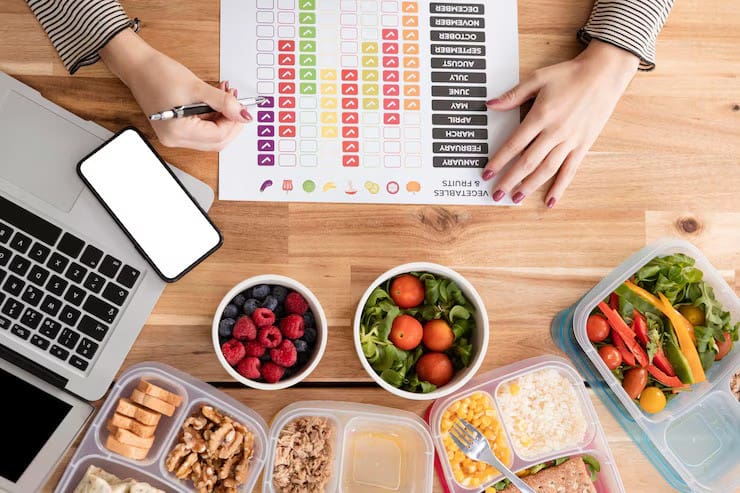Introduction
When it comes to losing 10 pounds in a month, one-size-fits-all diet plans might not always work. A personalized approach to diet and nutrition can make achieving this goal much easier and more sustainable. By tailoring a diet to fit your tastes, lifestyle, and unique needs, you increase your chances of losing weight fast in a healthy way. Let’s explore how to build a diet plan designed just for you that supports effective weight loss over the next 30 days.
1. Assess Your Current Eating Habits
Before jumping into a new diet, it’s crucial to understand your current eating habits. Take a week to track what you eat, when you eat, and any patterns that may influence your weight. This helps identify areas for improvement and gives you a clearer path to losing 10 pounds in a month.
How to Do It: Use a food journal or an app to log your meals and snacks. Record portion sizes, meal timing, and emotions around eating. This can help you spot patterns, like emotional eating or late-night snacking, which may impact your weight loss goals.
2. Set Realistic Weight Loss Goals
Setting specific and achievable goals is key to losing 10 pounds in a month. Instead of focusing solely on the end goal, break it down into smaller weekly targets, like losing 2-3 pounds per week. This approach keeps you motivated and gives you a sense of progress.
How to Do It: Set weekly targets to stay on track. Each week, aim for small, manageable changes that will add up over time. Celebrate small milestones to stay motivated, whether it’s fitting into a favorite pair of jeans or sticking to your diet for seven days straight.
3. Create a Balanced Meal Plan with Foods You Enjoy
A sustainable diet plan should include foods you genuinely like, as you’re more likely to stick with it. Choose nutrient-dense foods that help you feel satisfied while staying within your calorie goals. Building a personalized meal plan allows you to avoid “cookie-cutter” diets and craft a plan that keeps you motivated.
How to Do It: Include lean proteins, whole grains, and healthy fats in your meals. Aim for a balance where 45-65% of your daily calories come from carbs, 10-35% from protein, and 20-35% from fats. Including foods you love, like a bowl of berries or a slice of avocado toast, will help you stick with the plan.
4. Practice Portion Control
Portion sizes play a huge role in calorie intake. Eating large portions, even of healthy foods, can lead to weight gain or stall your progress. Portion control helps you consume fewer calories without feeling deprived, which is essential for achieving your goal to lose 10 pounds in a month.
How to Do It: Use visual cues to gauge portions. A typical portion of protein should be about the size of your palm, while grains should be the size of a fist. Fill half your plate with vegetables, a quarter with protein, and a quarter with grains to maintain balance.
5. Include Snacks Strategically
Snacks can either help or hinder your weight loss goals, depending on how you incorporate them. Opt for snacks that are high in protein and fiber, as these nutrients help keep you full and satisfied between meals, reducing the likelihood of overeating.
How to Do It: Choose snacks like Greek yogurt with berries, a handful of almonds, or carrot sticks with hummus. Including two snacks per day can help you avoid hunger without exceeding your daily calorie limit, supporting your goal to lose 10 pounds in a month.
6. Stay Hydrated to Support Metabolism
Hydration is essential for a healthy metabolism, and drinking enough water can help control hunger. Sometimes thirst is mistaken for hunger, leading to unnecessary snacking. Staying hydrated also supports digestion, which is essential for effective weight loss.
How to Do It: Aim to drink 8-10 glasses of water per day. If plain water is unappealing, add slices of lemon, cucumber, or fresh mint for flavor. Drinking a glass of water before meals can also help you feel full, making it easier to stick to smaller portions.
7. Build in Flexibility for Social Events and Treats
A personalized diet plan should accommodate real life. Allowing yourself occasional treats or a relaxed meal during social events can help you stay on track without feeling deprived. Flexibility makes it easier to stick to your diet for the full month.
How to Do It: Plan for a “treat meal” once a week where you enjoy your favorite food, like pizza or dessert. This way, you can satisfy cravings without compromising your progress. Remember, moderation is key, and occasional indulgence won’t stop you from losing 10 pounds in a month.
8. Track Your Progress and Adjust as Needed
Consistently monitoring your progress helps you stay on course and adjust your plan if needed. If you’re not seeing the expected results, tweak your diet by adjusting portion sizes or increasing physical activity. Keeping an eye on your progress ensures you stay motivated.
How to Do It: Track your weight weekly, as well as any changes in how your clothes fit. Also, monitor how you feel physically and emotionally on your diet. If you find that a specific approach isn’t working, don’t hesitate to make small adjustments to better support your goals.
Conclusion
Creating a personalized diet plan is a powerful strategy for losing 10 pounds in a month. By building a plan around your tastes, lifestyle, and goals, you’re setting yourself up for success in a way that’s both effective and enjoyable. Remember, consistency and enjoyment are key—when your diet feels right for you, sticking with it becomes second nature. Start planning today, and watch your progress as you get closer to your goal, one meal at a time.





